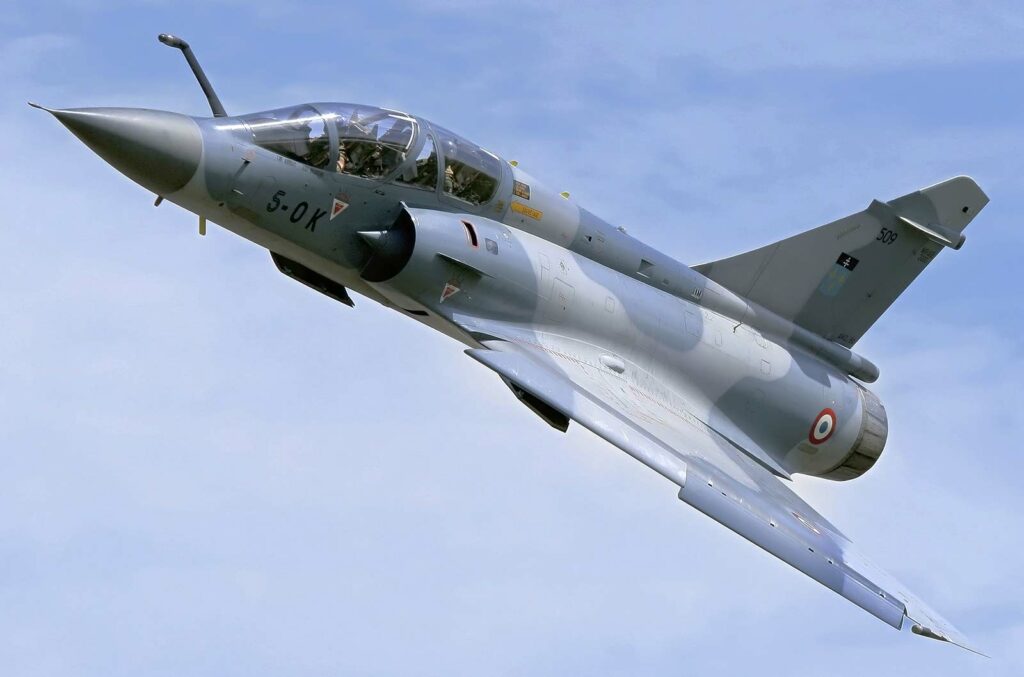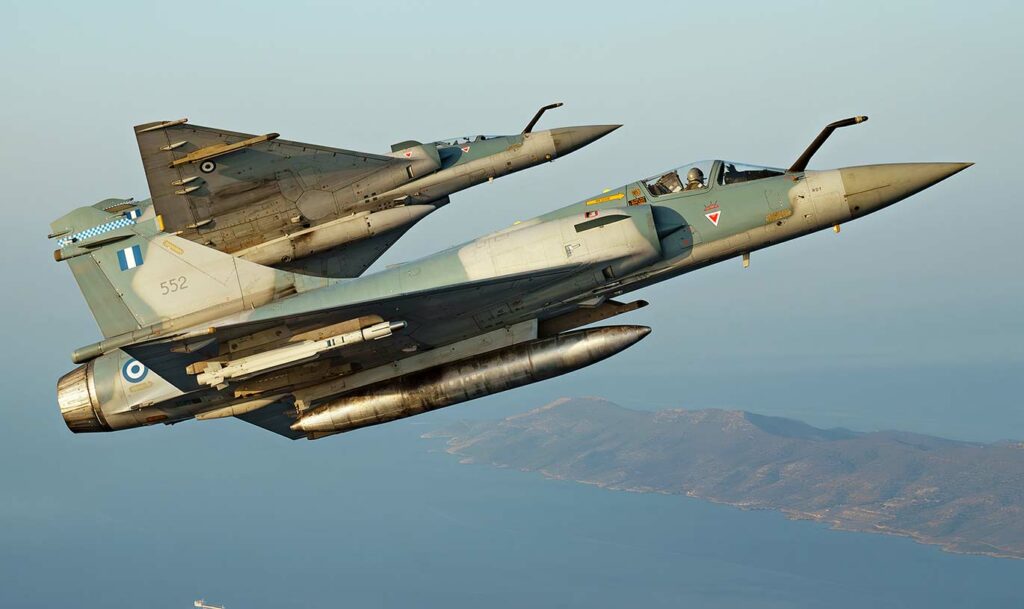French multirole, single-engine fourth-generation jet fighter designed for speed and agility.
In brief
The Dassault Mirage 2000 is a single-engine, delta-wing fighter jet developed by Dassault Aviation of France. It is equipped with a Snecma M53-P2 engine that delivers a thrust of 21,385 pounds, enabling a maximum speed of over Mach 2.2 (1,450 mph, 2,333 km/h). The aircraft has a service ceiling of 59,000 feet (18,000 meters) and a range of approximately 1,550 miles (2,500 km). Designed primarily for air superiority and precision strike missions, the Mirage 2000 features advanced avionics, including radar, electronic warfare systems, and a variety of integrated weapons systems.

History of the Development of the Dassault Mirage 2000
In the early 1970s, the global aviation community was rapidly evolving with the introduction of new technologies and capabilities. In this context, Dassault Aviation recognized the need for an advanced fighter that could maintain technological parity with contemporaneous developments in the United States and Soviet Union. The French government sought a versatile and highly capable aircraft that could handle multiple mission profiles, from air superiority to ground attack.
The Mirage 2000 was developed as a part of this strategic vision. The program officially started in 1972 when Dassault received the green light to create a successor to the Mirage III/5 family, aiming for a more agile and faster aircraft with modern avionics and better payload capacity. The project culminated in its first flight on March 10, 1978. The design philosophy focused on high performance, ease of maintenance, and operational versatility, aligning with France’s independent defense strategy post-NATO integration.
Design of the Dassault Mirage 2000
The Mirage 2000 sports a distinctive delta wing design, which contributes significantly to its agility and speed. It has an overall length of 47 feet (14.36 meters) and a wingspan of 29.8 feet (9.13 meters). The airframe is constructed primarily from aluminum alloys, with limited use of titanium and composites that provide a good balance between weight and durability.
Equipped with a single Snecma M53-P2 turbofan engine, the Mirage 2000 delivers 21,385 pounds of thrust, which is key to its excellent thrust-to-weight ratio and performance characteristics. The delta wing, while reducing aerodynamic drag at high speeds, does present challenges at lower speeds and higher angles of attack, requiring skilled piloting and sophisticated fly-by-wire control systems to manage effectively.
The aircraft’s avionics suite is centered around the Thomson-CSF RDM radar, which supports multi-target tracking and engagement. It integrates a wide array of weapons systems, including air-to-air missiles, air-to-ground munitions, and an internal cannon, allowing for flexible operation across combat scenarios.
Performance of the Dassault Mirage 2000
With its powerful engine, the Mirage 2000 achieves a maximum speed of over Mach 2.2 (1,450 mph, 2,333 km/h), and can reach an altitude of 59,000 feet (18,000 meters). Its combat range extends up to 1,550 miles (2,500 km) with external drop tanks. The aircraft’s performance is competitive with other fighters of its generation, such as the F-16 Fighting Falcon, offering comparable speed and agility but with the distinctive advantage of delta wing design that allows for exceptional maneuverability in dogfight situations.
Variants of the Dassault Mirage 2000
Several variants of the Mirage 2000 have been developed to suit various roles and requirements:
- Mirage 2000C: The original single-seat version designed for air interception.
- Mirage 2000B: A two-seat trainer variant without combat capability.
- Mirage 2000N/2000D: Optimized for all-weather nuclear strike and conventional attack roles.
- Mirage 2000-5: An upgraded multirole version with advanced avionics, improved radar, and the capability to deploy newer munitions.

Military Use and Combat of the Dassault Mirage 2000
The Mirage 2000’s operational history showcases its versatility and robust performance in multiple conflict zones, reflecting its strategic importance to the French Air Force and its international partners.
Gulf War (1990-1991):
During the Gulf War, France deployed its Mirage 2000 aircraft as part of Operation Desert Storm, the international coalition effort to expel Iraqi forces from Kuwait. The Mirage 2000s were primarily used for air superiority missions to gain control of the airspace and for ground attack operations against Iraqi military installations and forces. The aircraft’s delta wing design allowed for high-speed interceptions and maneuverability in dogfights, while its sophisticated avionics enabled effective ground targeting in a complex battlefield environment. The Mirage 2000 pilots employed a range of weaponry from conventional bombs to laser-guided munitions, demonstrating the aircraft’s adaptability to different combat roles. Their operational success in these missions helped to cement the Mirage 2000’s reputation for reliability and effectiveness in combat.
Kosovo War (1999):
In the late 1990s, the Mirage 2000 was again called into action during the NATO intervention in Kosovo, known as Operation Allied Force. The mission aimed to force the Yugoslav forces to withdraw from Kosovo and end the humanitarian crisis in the region. Mirage 2000s participated in air strikes against strategic targets across Yugoslavia, employing precision-guided munitions to minimize collateral damage and increase mission effectiveness. The aircraft’s sophisticated navigation and targeting systems were crucial in the challenging weather conditions and robust air defenses of Yugoslavia. The Mirage 2000s’ contributions were significant in the successful air campaign, which ultimately led to the withdrawal of Yugoslav forces from Kosovo.
Operations in Afghanistan (2001 onwards):
Following the September 11 attacks in 2001, the Mirage 2000 was deployed to Afghanistan as part of the international military response against the Taliban and al-Qaeda. Operating in the rugged terrain and at high altitudes of Afghanistan posed new challenges, including the need for precise strikes to support ground troops while avoiding collateral damage in densely populated areas. The Mirage 2000s used a mix of direct and stand-off weapons, demonstrating the platform’s flexibility and the pilot’s adeptness at handling a variety of combat scenarios from close air support to reconnaissance.
Libyan Conflict (2011):
During the Libyan civil war in 2011, as part of Operation Harmattan (the French participation in NATO’s Operation Unified Protector), Mirage 2000s were extensively used for enforcing the no-fly zone and conducting ground strikes against the Libyan regime’s military assets. Their missions included air patrols, reconnaissance, and precision strikes, showcasing the aircraft’s enduring capability to operate effectively in joint and coalition operations. The Mirage 2000s were instrumental in the NATO-led efforts that ultimately led to the toppling of Muammar Gaddafi’s regime.
In each of these conflicts, the Mirage 2000 demonstrated its high survivability, operational flexibility, and effectiveness across a broad spectrum of mission profiles, reinforcing its status as a versatile and capable multirole fighter jet in the international arena.
It has been exported to multiple countries, including India, Egypt, and the United Arab Emirates, each customizing the platform to their specific defense needs. The Mirage 2000 continues to be a critical component of several nations’ defense strategies, though some operators are beginning to phase them out in favor of newer generation aircraft like the Rafale.
The Dassault Mirage 2000 remains a testament to French engineering prowess and strategic foresight. With its advanced design and versatile capabilities, it continues to serve effectively in various roles across multiple air forces, maintaining relevance in modern aerial combat despite the advent of newer technologies.
Back to the Fighter Jet section.